 Bob Flowerdew’s Complete Fruit Book is worth reading for the recipes and color pictures, even if you don’t grow fruit. But if you do, you will find details on history, care and maintenance of the fruit garden instructive and you may be inspired to grow some of the more exotic varieties he describes. Flowerdew writes about normal fruits and nuts from apples to walnuts and everything in between, including unusual fruits like sapodillas and Cornelian cherries.
Bob Flowerdew’s Complete Fruit Book is worth reading for the recipes and color pictures, even if you don’t grow fruit. But if you do, you will find details on history, care and maintenance of the fruit garden instructive and you may be inspired to grow some of the more exotic varieties he describes. Flowerdew writes about normal fruits and nuts from apples to walnuts and everything in between, including unusual fruits like sapodillas and Cornelian cherries.
Timber Press Guide to Gardening in the Pacific Northwest
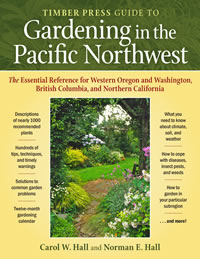 When authors Carol and Norman Hall started gardening in the Pacific Northwest in the 1970’s they had to learn to grow their plants by trial and error, because most gardening books of the time addressed only East Coast weather conditions, such as summer rain and winter freezing.
When authors Carol and Norman Hall started gardening in the Pacific Northwest in the 1970’s they had to learn to grow their plants by trial and error, because most gardening books of the time addressed only East Coast weather conditions, such as summer rain and winter freezing.
However, perhaps it’s just as well the authors had to figure it out on their own because their depth of understanding how the Pacific Northwest climate affects plants is impressive. Although the question of where the boundaries of the Pacific Northwest lie is open to debate, the Halls define them as: the areas stretching between the ocean coast and the Cascade Range, and between latitude 51° in British Columbia and latitude 41° in northern California. The northern boundary was chosen because north of latitude 51° the “difference between high and low temperatures become smaller and light intensity starts to diminish even on clear days… gardening conditions beyond this point are not those of the Pacific Northwest, but those of coastal Alaska.” The southern border seems a bit more arbitrary, especially on the coast, but the authors note: “It’s only after negotiating the steep descent from [the Cascade Range] to the valley floor and seeing the palm trees lining the streets of Redding, California, that you know you’ve suddenly entered a whole new gardening world.” The unifying climatic conditions that defines the region are wet, mild winters and dry summers.
This large format book with 351 pages and a liberal use of color photographs is divided into 4 sections: the region, 12 month maintenance calendar, recommended plants and common problem & solutions.
Detailed descriptions of climate, soils and horticultural conditions are given about the region’s seven sub-regions, which include: the Georgia Basin/Puget Trough, the Olympic Rain Shadow, Puget Sound, Pacific Coast (northern section), Pacific Coast (southern section), the Cascade Slopes/Outflow Valleys and Willamette. The authors recommend their favorite plants that grow well in the Pacific Northwest according to plant types such as: ornamental trees, shrubs, bulbs, and others. Instructions on caring for the recommended plants always refer to specific Pacific Northwest climate considerations. For example, heaths and heathers need supplemental water during our typical regional summer droughts for the first two years, until they become established.
This is an excellent general gardening reference that focuses on the Pacific Northwest climate like no other.
Excerpted from the Winter 2009 Arboretum Bulletin.
The Wild Places
 Though I will probably never survey my surroundings from the top of a tall beech tree, or climb a frozen waterfall in the dark, I thoroughly enjoyed discovering unspoiled natural areas of Britain through Robert Macfarlane’s book The Wild Places (Granta Books, 2007).
Though I will probably never survey my surroundings from the top of a tall beech tree, or climb a frozen waterfall in the dark, I thoroughly enjoyed discovering unspoiled natural areas of Britain through Robert Macfarlane’s book The Wild Places (Granta Books, 2007).
In richly descriptive prose, he leads the reader to these increasingly rare spots on the map, from saltmarshes and moors to hedgerows and holloways (tunnels of vegetation). Under the tutelage of his friend Roger Deakin (author of Wildwood, who died in 2007), Macfarlane’s conception of wildness evolves over the course of his travels to include the humbler, smaller wild places that are within reach of even the most city-bound nature lovers:
“I thought about how the vision of wildness with which I had begun my journeys – inhuman, northern, remote – was starting to crumble from contact with the ground itself… The human and the wild cannot be partitioned. Everywhere that day I had encountered blendings and mixings.”
Encyclopedia of Northwest Native Plants for Gardens and Landscapes
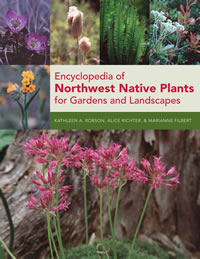 For gardeners, the most important new book of the year will be the “Encyclopedia of Northwest Native Plants for Gardens and Landscapes”. A trio of southwest Washington writers brings extensive experience in botany, propagating and growing native plants, and photography together in this very comprehensive and extensive book that will be a standard reference for many years to come.
For gardeners, the most important new book of the year will be the “Encyclopedia of Northwest Native Plants for Gardens and Landscapes”. A trio of southwest Washington writers brings extensive experience in botany, propagating and growing native plants, and photography together in this very comprehensive and extensive book that will be a standard reference for many years to come.
A brief introduction lays the ground rules: only natives — nothing naturalized since the arrival of “non-indigenous human explorers”. Plants that are rare and nearly impossible to grow in cultivation are out, too. An example being the various lovely but sensitive slipper orchids.
There are some seeming exceptions to this last rule, such as Erythronium montanum, the stunning but notoriously difficult-to-cultivate avalanche lily seen at Hurricane Ridge. However, the authors note, it can be grown by gardeners who live at higher elevations.
The heart of the book is a listing of over 500 species that gives a basic description, cultivation requirements, native range and habitat, plus notes about related species, ethnobotany and selected varieties. Propagation tips are included, with a strong emphasis on conservation of plants in situ.
The excellent photographs make this a pretty good identification book, too, and will convince you to add more natives to your home garden, including ferns, shrubs, and trees, both broad leaf and conifers. The appendices include helpful lists of plants to meet various gardening needs (for shade, for wildflower meadows, for hummingbirds, etc.). This book is a must have!
Excerpted from the Fall 2008 Arboretum Bulletin.
Best Plant Picks
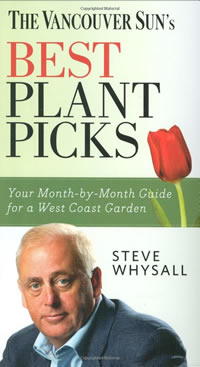 Steve Whysall has been a regular garden writer for the Vancouver Sun for 15 years. “Best Plant Picks” selects trees, shrubs, perennials, bulbs, and ferns from his more recent columns and organizes them in a gardening calendar, including tips on monthly chores and seasonal highlights. While not a major departure for the author’s earlier books, there are some interesting juxtapositions here. A good choice for a new gardener who is willing to experiment.
Steve Whysall has been a regular garden writer for the Vancouver Sun for 15 years. “Best Plant Picks” selects trees, shrubs, perennials, bulbs, and ferns from his more recent columns and organizes them in a gardening calendar, including tips on monthly chores and seasonal highlights. While not a major departure for the author’s earlier books, there are some interesting juxtapositions here. A good choice for a new gardener who is willing to experiment.
Excerpted from the Fall 2008 Arboretum Bulletin.
Handbook of Northwest Gardening
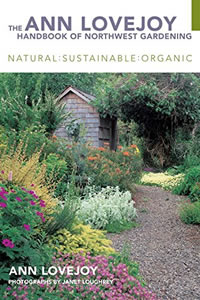 Ann Lovejoy has updated her popular 2004 “Handbook of Northwest Gardening,” with a new appendix entitled “What’s New in Sustainable Gardening.” Here she discusses rain gardens (that capture as much of naturally occurring water as possible), dry gardens (plantings that survive and even thrive with no supplemental watering once established), and the importance of bees and their current peril — and ways that gardeners can help their cause. All good additions.
Ann Lovejoy has updated her popular 2004 “Handbook of Northwest Gardening,” with a new appendix entitled “What’s New in Sustainable Gardening.” Here she discusses rain gardens (that capture as much of naturally occurring water as possible), dry gardens (plantings that survive and even thrive with no supplemental watering once established), and the importance of bees and their current peril — and ways that gardeners can help their cause. All good additions.
Excerpted from the Fall 2008 Arboretum Bulletin.
Holden Village Historic Iris
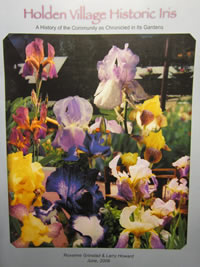 One of the most unique books in the Elisabeth C. Miller Library collections is “Holden Village Historic Iris,” the accounting of the surviving garden iris from the village of a mining camp that operated near the upper end of Lake Chelan from 1937 – 1957. Now established at a nearby Lutheran ministry known as Holden Village, these irises are a living history. Grown by the wives of the miners, many survived untended for more than 40 years in abandoned gardens.
One of the most unique books in the Elisabeth C. Miller Library collections is “Holden Village Historic Iris,” the accounting of the surviving garden iris from the village of a mining camp that operated near the upper end of Lake Chelan from 1937 – 1957. Now established at a nearby Lutheran ministry known as Holden Village, these irises are a living history. Grown by the wives of the miners, many survived untended for more than 40 years in abandoned gardens.
Newer varieties were added after the village was established in the early 1960’s, but like the older varieties, the “real” names are mostly unknown. Instead, authors Roxanne Grinstad and Larry Howard (the latter a garden volunteer at the Center for Urban Horticulture) share the local names that reflect the flowers’ place in the community, evocative of both the present day and the history of the area.
Excerpted from the Fall 2008 Arboretum Bulletin.
The Flower Hunter
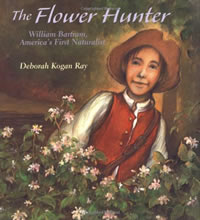 “My father, John Bartram, is a botanist. He studies plants and trees. I help him with his work. My name is William, but everyone calls me Billy. Father calls me his ‘little botanist.'”
“My father, John Bartram, is a botanist. He studies plants and trees. I help him with his work. My name is William, but everyone calls me Billy. Father calls me his ‘little botanist.'”
Thus Deborah Kogan Ray begins her first person narrative of the life of William Bartram (1739-1823) in “The Flower Hunter,” a book written for children that can be read with enjoyment by adults as well. Much has been written about this early American naturalist and artist — and his equally famous botanist father, John Bartram (1699-1777) — but none can match the charm of this 40-page book, which is richly illustrated by the author.
“The Flower Hunter” tells the story of a young boy who grows up on a farm near Philadelphia and early becomes fascinated by his father’s love of plants and botanical exploration. Throughout his childhood, Billy’s father leads him on field trips that range farther and farther away from the farm. Eventually their roles reverse, and the son becomes an explorer who returns home triumphantly to share his discoveries about the natural world with his aging father.
Kogan Ray places her straightforward account against a wider backdrop — the struggles of an emerging nation and the hardships and thrills of travel through a landscape and time very different from today. New plants, animals and even peoples are waiting to be found, described and – unusual for scientific traditions of the time — cherished in their natural state.
Why do the Bartrams remain important to us now? Together they discovered the Franklin tree (Franklinia alatamaha) in coastal Georgia in 1765; a short time later the tree became extinct in the wild. An example of this beautiful tree, that blooms in autumn while its foliage is turning bright red, can be found on the east edge of the Arboretum’s Azalea Way, about 100 yards north of the Winter Garden.
While today’s botanic gardens and arboreta would be duller places without the Franklin tree, the Bartrams left us far more than this one showstopper. Their farm became one of the first botanic gardens in the United States, and is open to the public. (see “Bartram’s Garden website). And they were instrumental, along with their friend Benjamin Franklin and others, in developing an American tradition of studying the natural sciences.
Perhaps best, they both wrote detailed journals of their travels. William’s “Travels,” published in 1791, is still in print today and is credited by Kogan Ray with having “inspired Henry David Thoreau and Charles Darwin with its observations of the world of nature.”
Excerpted from the Summer 2008 Arboretum Bulletin.
The Art and Science of William Bartram
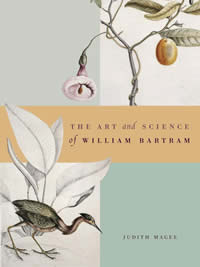 Children’s books may lead to some interesting discoveries in adult literature. The story of Billy, the little botanist, grows up in “The Art and Science of William Bartram” by Judith Magee. Here the simple leaf-drawing boy is revealed as more than an intrepid explorer and skilled artist of nature.
Children’s books may lead to some interesting discoveries in adult literature. The story of Billy, the little botanist, grows up in “The Art and Science of William Bartram” by Judith Magee. Here the simple leaf-drawing boy is revealed as more than an intrepid explorer and skilled artist of nature.
Despite the title and the inclusion of nearly 70 of William’s drawings, many of birds, fish, and reptiles in addition to plants, this is not primarily an art book. It is a wide-ranging narrative that places the Bartrams, in particular William, in the context of the science, philosophy, religion, culture, and politics of their time.
Excerpts from publications, journals, and correspondence are skillfully woven into a narrative that I found as engaging as the simple tale in “Flower Hunter.” Extensive asides profile important associates, many which were themselves instrumental in the beginnings of the American scientific community.
Throughout Magee concludes that William Bartram was not fully appreciated in his own time and place. His astute concerns about the ecology (well before the term was coined) of the natural world, and his beliefs in the equality of the Native Americans, were views shared by very few others. She sees his influence not only in botany, zoology and ethnography, but also on the European poets of Romanticism at the turn of 19th century.
When studied today, the author concludes William is “often seen as a pioneer in the field of ecology, a radical rather than a conservative in his politics, nationalism and religion, and a Romantic rather than a man of the Enlightenment.” It is also noteworthy that he spent a long retirement in his garden, as it “remained the single most important thing” in his later years.
Excerpted from the Summer 2008 Arboretum Bulletin.
4 Gardens in One
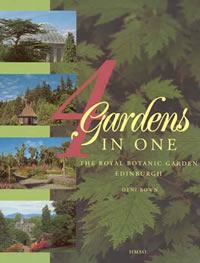 “4 Gardens in One,” by Deni Bown is an excellent source for learning about the four sites of the Royal Botanic Gardens Edinburgh. Written with passion and an eye for lively history — Bown took the photographs, too — in her details about the Younger Botanic Garden at Benmore, I learned the full truth of Rhododendron ponticum. “Even today one will encounter areas in the far west of the garden which are yet to be cleared; these are still ponticum territory and virtually impenetrable.”
“4 Gardens in One,” by Deni Bown is an excellent source for learning about the four sites of the Royal Botanic Gardens Edinburgh. Written with passion and an eye for lively history — Bown took the photographs, too — in her details about the Younger Botanic Garden at Benmore, I learned the full truth of Rhododendron ponticum. “Even today one will encounter areas in the far west of the garden which are yet to be cleared; these are still ponticum territory and virtually impenetrable.”
Excerpted from the Winter 2008 Arboretum Bulletin.